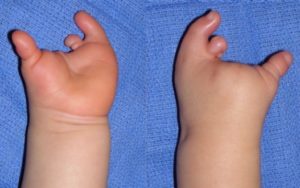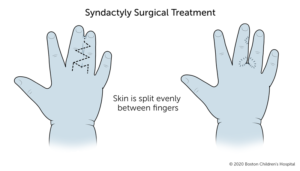Webbed Fingers or Syndactyly
Syndactyly means a medical condition in which toes or fingers are webbed together. It is also known medically as webbed fingers. Webbed fingers are a common condition in humans. This situation occurs when two or more fingers or toes are fused due to tissues and bones during fetal development. Read More
Top Doctors For Webbed Fingers or Syndactyly Treatments
Top Hospitals For Webbed Fingers or Syndactyly Treatments
Webbed Fingers or Syndactyly
What is Syndactyly?
Syndactyly means a medical condition in which toes or fingers are webbed together. It is also known medically as webbed fingers. Webbed fingers are a common condition in humans. This situation occurs when two or more fingers or toes are fused due to tissues and bones during fetal development. The middle and ring fingers space is the most common location for syndactyly [1].Syndactyly classification

- Symbrachydactyly

- Amniotic band syndrome

Treatment for Syndactyly

Syndactyly surgery
- The surgery is generally performed under local anesthesia to avoid pain. The area to be operated is draped and prepped.
- A surface suited for surgery is made for proper incision, and the angle may be curved to support the finger.
- The zigzag is constructed to provide a mirror image of the palm. The cut in the shape of T is made to adjust in between the flaps.
- After positioning, the bandage is applied on the hand and elevation of the tourniquet up to 250 mm hg pressure is done.
- Along with checking the bleeding points, sharp dissection is made to lift the flaps.
- Then Neuromuscular tissue is examined, and the connected fingers are separated.
- A Digital artery must be present in each digit as it can be ligated if the artery on the other side is intact.
- Then a vertical cut is made and expanded to rectify the space on the volar side, and a small cut is made to bring the flaps up.
- After adequate fixation and check on bleeding, dressing is done to avoid infection in the area.
- You should keep the dressing as it is for 2-3 weeks. After that, replace it with a fresh dressing followed by cleaning and applying prescribed medication.
Advantages of syndactyly surgery
Painless surgery and scar disappearance after the surgery leave no trace memories for babies.Disadvantages of syndactyly surgery
If they feel pain, discomfort, and improper functioning, the patient may require several other treatments. However, it is an uncommon situation.Skin grafting
The skin grafting requires the removal of webbing through a cut made in the shape of ‘Z’ around the area. Frequently, additional skin is added to the separated area to fill the gap, and the skin is detached from the ample skin location. This process of cutting skin from one area to wrap another area is called skin grafting. The skin graft is usually taken from the elbow or wrist crease to minimize skin scarring. Other supplement surgeries may be done depending on the situation for improved results. Skin grafting is an expensive surgery, and the cost of the procedure differs in hospitals ranging between $18,000 and $28,000.After-effects of surgery
It is common to feel pain and discomfort for some time. Proper care will be advised for a few weeks to help it heal sooner. Restrict range of motion along with swelling and stiffness in the area.Causes
Webbed fingers occur randomly and the reason is vague. Some observations state that genetic disorders like Apert syndrome and down syndrome. This disorder results in improper growth of the bones. Syndactyly occurs when hands and feet are unable to form properly. This process occurs during 7-8 weeks of pregnancy. During the development phase, all fingers are connected, after some time these connections vanish thus making individual fingers. When abnormalities occur, it hinders the proper growth which leads to syndactyly or webbed fingers.
- Apert syndrome: Though a rare disorder, it can be attributed as a hereditary disorder which leads to deformity or deformation of hands, skull, feet and face. This problem often results in webbed fingers in new-born babies due to premature closure of bones in the skull. Notable features of Apert syndrome are simple webbed fingers of webspace, shorter thumb and complex syndactyly between fingers. Some other symptoms observed are underdevelopment of the jaw, small nose, webbed fingers and toes, high forehead with a taller skull, retarded mental growth and bulging eyes.
- Down syndrome: Another cause of syndactyly is down syndrome also known as trisomy 21. It is defined as a disorder caused by an extra or third replica of chromosome 21 during cell division. The condition causes delay in intellectual development, physical development and uncommon features. The life expectancy of babies with Down Syndrome is less as compared to non-affected babies, Down syndrome leads to a low immune system. The babies diagnosed with the condition are likely to suffer other problems like leukaemia, mental defects, heart disease and thyroid disorders. Some more symptoms include shorter hands, uneven teeth, umbilical hernia, retarded growth, excess fat on the back of the neck, flat nose and flathead.
FAQ
- What is the cost of syndactyly surgery?
The cost of syndactyly surgery ranges between $2500 and $6100. However, the other formalities may cost separately depending on the hospital’s needs. The cost differs from place to place.
- What are the side effects of syndactyly surgery?
Syndactyly surgery side effects are stiffening of the scarred tissue, and unwanted skin may grow back, requiring additional surgery.
- How should a patient prepare for webbed fingers surgery?
Someone for assistance should accompany a patient should follow the surgical routine advised by the doctor.
- Does syndactyly go away?
Syndactyly can be treated and cured with the help of surgery if needed. Usually, patients do not require treatment, and it is not often recommended since functioning is more important than shape.
- What is the time duration for syndactyly surgery?
The procedure takes around 1-2hrs. The area is sensitive for weeks which demands extra care and dressings.
- What are the complications of syndactyly surgery?
Complications include finger ischemia, recurrence of syndactyly, various skin-graft complications, and contracture (condition of hardening and shortening of muscles, tendons and tissues) [3].
References
- https://www.stanfordchildrens.org/en/service/hand-upper-limb-surgery/syndactyly?#:~:text=What%20is%20syndactyly%3F,separate%20fully%20during%20fetal%20development.
- https://www.stanfordchildrens.org/en/service/hand-upper-limb-surgery/syndactyly?#:~:text=What%20is%20syndactyly%3F,separate%20fully%20during%20fetal%20development.
- emedicine



















































































